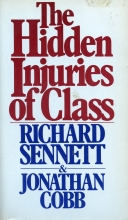

|
|

The Hidden Injuries of Class
Sennett, Richard; Cobb, Jonathon
Publisher: Random HouseYear First Published: {16245 The Hidden Injuries of Class HIDDEN INJURIES OF CLASS Sennett, Richard; Cobb, Jonathon Random House Sennett and Cobb look at human relations between people of different classes and analyze everyday life and ordinary situations to identify class signals that make people feel inadequate. 1966 1972 275pp BC16245-InjuriesofClass.jpg B Book 0-394-46212-2 HD8072.s487 301.44'42'0973 "It's not what you are, but what you do." This is the notion that Sennett and Cobb oppose in The Hidden Injuries of Class. They analyze everyday life and ordinary situations to identify class signals that make people feel inadequate. Their book looks at human relations between people of different classes. It is a sociological description of class conflict that focuses on how workers feel when addressing their bosses, and how individuals feel when dealing with people in a higher standing. The conclusion advocates the end of judgement based on success in the most desirable jobs and materialistic factors. <br> <br>Along with an introduction and a conclusion, there are two parts to the book: The Sources of Injury, and Dreams and Defences. Sources of Injury claims that, "dignity is as compelling a human need as food or sex," while Dreams and Defences discusses how the psyche defends itself from society in one of two ways: alienation or dream-chasing. The freedom to live as one desires and to pursue goals that are more prestigious is appealing enough to ward off the judgements of the upper class. "If I let the dream of a common dignity grow strong in me, then I want the barriers of privilege removed so that I can develop this potential." In the conclusion it is established that the remaining hierarchy in society and the scales by which we judge ourselves and others will result in revolution unless we achieve true egalitarianism through dignity for all. <br> <br>[Abstract by Mia Manns] <br> <br> <br>Table of Contents <br> <br>Personal Acknowledgements <br>Foreword <br> <br>Introduction Hidden Injuries <br> <br>Part One The Sources of Injury <br>Badges of Ability <br>Sacrifice and Betrayal <br>The Uses of Injured Dignity <br> <br>Part Two Dreams and Defense <br>The Divided Shelf <br>Freedom <br> <br>Conclusion A Flawed Humanism <br> <br>Afterword, by Jonathan Cobb <br>Related Writings of Interest CX7452 0 false true false CX7452.htm [0xc001200450 0xc0001a62d0 0xc0001a7b30 0xc0001d4a80 0xc00024d6b0 0xc0002653b0 0xc000283440 0xc0002837a0 0xc000305c20 0xc000490120 0xc001631470 0xc002528390 0xc000a70330 0xc000a71dd0 0xc002a85890 0xc002a97080 0xc002aad740 0xc002aadcb0 0xc002ac2d50 0xc000f54480 0xc002c1aae0 0xc002c1ac30 0xc002c1b1d0] Cx} Year Published: 1972 Pages: 275pp ISBN: 0-394-46212-2 Library of Congress Number: HD8072.s487 Dewey: 301.44'42'0973 Resource Type: Book Cx Number: CX7452 Sennett and Cobb look at human relations between people of different classes and analyze everyday life and ordinary situations to identify class signals that make people feel inadequate. Abstract: "It's not what you are, but what you do." This is the notion that Sennett and Cobb oppose in The Hidden Injuries of Class. They analyze everyday life and ordinary situations to identify class signals that make people feel inadequate. Their book looks at human relations between people of different classes. It is a sociological description of class conflict that focuses on how workers feel when addressing their bosses, and how individuals feel when dealing with people in a higher standing. The conclusion advocates the end of judgement based on success in the most desirable jobs and materialistic factors. Along with an introduction and a conclusion, there are two parts to the book: The Sources of Injury, and Dreams and Defences. Sources of Injury claims that, "dignity is as compelling a human need as food or sex," while Dreams and Defences discusses how the psyche defends itself from society in one of two ways: alienation or dream-chasing. The freedom to live as one desires and to pursue goals that are more prestigious is appealing enough to ward off the judgements of the upper class. "If I let the dream of a common dignity grow strong in me, then I want the barriers of privilege removed so that I can develop this potential." In the conclusion it is established that the remaining hierarchy in society and the scales by which we judge ourselves and others will result in revolution unless we achieve true egalitarianism through dignity for all. [Abstract by Mia Manns] Table of Contents Personal Acknowledgements Foreword Introduction Hidden Injuries Part One The Sources of Injury Badges of Ability Sacrifice and Betrayal The Uses of Injured Dignity Part Two Dreams and Defense The Divided Shelf Freedom Conclusion A Flawed Humanism Afterword, by Jonathan Cobb Related Writings of Interest Subject Headings |